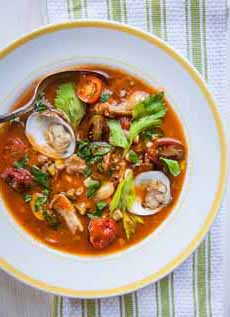TODAY IN FOOD: It’s National Clam Chowder Day
|
|
We’re happy as a clam that today, February 25th, is National Clam Chowder Day. (Although as our colleague Philip has always asked, why is a clam so happy? It sits immobile on the ocean floor, waiting to be scooped up for someone’s dinner.) You can celebrate with New England Clam Chowder (sometimes called Boston Clam Chowder), Manhattan Clam Chowder or Rhode Island Clam Chowder. Restaurants tend to serve one type or the other. New England Clam Chowder is the oldest version. According to the book 50 Chowders by Jasper White, the oldest-known printed chowder recipe is for fish chowder, printed in the Boston Evening Post on September 23, 1751. It calls for onions, pork, salt, pepper, parsley, sweet marjoram, savory, thyme and a biscuit (later replaced by oyster crackers or saltines served with the soup)—ingredients that are still used today. There are other chowders, like corn chowder, fish chowder, lobster chowder, even tofu chowder. But today, it’s all about clam chowder. All chowders tend to be made with potatoes, onions, and of course, clams. If you have a shellfish allergy, you can opt for Fish Chowder, which substitutes shredded fish, often cod, for the clams, and throws in corn kernels for good measure. |
|
|
The word chowder has its roots in the Latin word calderia, which originally meant a hearth for warming things and later came to mean a cooking pot. The word evolved to cauldron, which in French became chaudiere, a heartbeat from chowder. The first chowders in our culture were fish chowders, made in cauldrons in fishing villages along the coast of France and in the Cornwall region of Southwestern England. When the fishermen came to the New World, they found clams in huge supply along the northern Atlantic coast, and clam chowder was born. Here’s a review of one of our favorite New England Clam Chowders, available by the can from Bar Harbor Foods. CHECK OUT WHAT’S HAPPENING ON OUR HOME PAGE, THENIBBLE.COM. |
||




